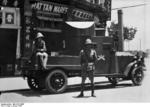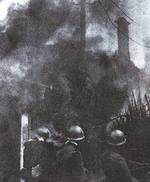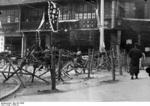First Battle of Shanghai
Contributor: C. Peter Chen
ww2dbaseIn Sep 1931 the Mukden Incident led to Japanese troops entering northeastern China, which subsequently led to the establishment of the puppet state Manchukuo in Feb 1932. The occupation of northeastern China by Japanese troops deeply humiliated the Chinese, leading to mass protests (mostly by students) against Japanese spheres of influence and called for a wide boycott of Japanese goods. Scenes of public burning of Japanese goods were not uncommon. Much of the hatred for the Japanese was also rooted in the First Sino-Japanese War that took place only thirty years earlier. One of such protests turned violent, resulting in the injury of several Japanese officials. Soon after, a group of Chinese soldiers "violated" boundaries forcefully set by the Japanese of where the Chinese military could operate in Shanghai, clashing with Japanese in the city. The Japanese government, which held 7,000 troops outside the city centered around a sizeable naval fleet, demanded apology and monetary compensation from the government in Shanghai, who helplessly complied. Nevertheless, Japanese carrier aircraft bombed the city on 28 Jan 1932; it was the first major aircraft carrier action in the Far East. Following the bombing, 3,000 Japanese troops marched into Shanghai, clashing with the Chinese 19th Route Army. Despite urgings from the United States and Britain to cease aggression even before the violence had broken out, Japan continued fighting.
ww2dbaseOn 30 Jan, Chiang Kaishek met with his advisers in Nanjing and decided to temporarily move the capital from Nanjing to Luoyang as an emergency measure due to Nanjing's proximity to Shanghai. Chiang stressed the importance for the 19th Route Army to hold Shanghai, and assigned the defense of Nanjing to the 61th Division and the German-trained 87th and 88th Divisions. The three divisions in Nanjing was to serve as reserve forces for Shanghai.
ww2dbaseBy mid-Feb, Japanese 24th Mixed Brigade and 9th Division had both arrived in Shanghai as reinforcements. On 14 Feb, at the request of the Chinese 19th Route Army, the 87th and 88th Divisions, support by other independent units, were sent in to Shanghai as the 5th Army. At the time, the 5th Army was considered the best fighting force in China due to its superb German training and modern equipment.
ww2dbaseBy 18 Feb, the reinforcements had arrived in the suburbs of Shanghai. At 0730 on 20 Feb, Japanese aircraft and artillery bombarded elements of the Chinese 88th Division near Miaoxing, followed by an attack by the 24th Mixed Brigade. The defenders held ground, and the Japanese could do little but continue the bombardment. In the morning of 22 Feb, a sudden attack by the Japanese to the east of Miaoxing collapsed the Chinese line, but a costly Chinese counterattack during the day drove the Japanese back by 2030 that evening. The counterattack cost the Chinese 20 officers killed and 2,000 casualties total.
ww2dbaseIn Shanghai, fierce street fighting in the Chapei district often characterized the brutal fighting in this battle. Eventually the Japanese forces grew to a size larger than 100,000 troops supported by naval vessels and aircraft, while the ill-equpped Chinese defenders in the city fielded only half the amount of men.
ww2dbaseBeginning from 25 Feb, the Japanese changed tactics. While the troops in Shanghai continued to exert pressure just the same, the forces outside shifted the main attack near Maijiazhai where the Chinese 87th Division defended. At 0800 on 26 Feb, after a 100-minute long artillery barrage that ripped apart most defensive works, the Japanese rushed Maijiazhai, pushing back the line by 1100. The 19th Route Army sent elements from the 61th and 78th Divisions from Shanghai to reinforce the 87th Division, and eventually pushed back the Japanese.
ww2dbaseOn 29 Feb, the Japanese 11th Division landed near Liuhe behind Chinese lines, tying down the Chinese troops in a desperate defense to prevent the Japanese from establishing a strong beachhead. The troops in Shanghai launched a coordinated attack with the 11th Division starting on 1 Mar. By the end of the next day, the 19th Route Army retreated from the city, marking the official end of the battle within the city, though sporadic fighting persisted.
ww2dbaseBetween 3 Mar and 8 Mar, 7,000 to 8,000 Japanese attacked against Chinese forces outside the city continued. The Chinese fought on stubbornly, but eventually was no match against the Japanese. After losing over 100 officers killed and suffering over 13,000 casualties, the Chinese withdrew. The German-trained elite 87th and 88th Divisions suffered 5,380 casualties, which was of grave damage to overall Chinese strength.
ww2dbaseOn 5 May, the Shanghai Ceasefire Agreement was signed. Areas around Chinese cities of Shanghai, Suzhou, and Kunshan were to be free of Chinese military; the cities were instead to be under the protection of the Japanese. This agreement angered the Chinese, some accused the western powers of appeasing to the aggression shown by Japan. Although this battle was fought without a formal declaration of war, it was considered by some as the start of the Second Sino-Japanese War.
ww2dbaseThis battle saw the establishment of the comfort women system by the Japanese troops in China. The system was established with the original purpose of preventing the desire for raping Chinese women and to prevent the outbreak of venereal diseases among Japanese ranks. Though as the war progressed, the comfort women system was to become something completely different.
ww2dbaseSources: the Second Sino-Japanese War, Tales of Old China, Wikipedia.
Last Major Update: Jun 2007
First Battle of Shanghai Interactive Map
Photographs
 |  |  |  |
First Battle of Shanghai Timeline
| 20 Jan 1932 | Japan demanded China to dissolve anti-Japanese organizations and pay compensation for losses incurred due to Chinese boycotts of Japanese goods. |
| 28 Jan 1932 | The First Battle of Shanghai began in China. |
| 29 Jan 1932 | Japanese aircraft attacked the Chapei district of Shanghai, China, causing 1,000 deaths, most of which were civilian. |
| 1 Feb 1932 | Japanese carrier Hosho and the Japanese Navy Destroyer Division 3 arrived off Shanghai, China to support the battles in the city. Also on this day, the United Kingdom and the United States demanded Japan to cease the fighting in Shanghai. |
| 5 Feb 1932 | Two Japanese bombers and three carrier-borne (Hosho) biplane fighters engaged in dogfights with Chinese Air Force fighters over Shanghai, China. |
| 7 Feb 1932 | Part of the air groups from Japanese carriers Kaga and Hosho was dispatched to Shanghai, China to support fighting on the ground. |
| 22 Feb 1932 | Three Japanese carrier-borne (Kaga) bombers, escorted by six fighters, was attacked by Chinese fighters over Shanghai, China; a biplane, piloted by American volunteer Robert Short, shot down one bomber before being shot down himself. |
| 29 Feb 1932 | Japanese 11th Infantry Division landed near Liuhe behind Chinese lines in Shanghai, China. |
| 1 Mar 1932 | Chinese troops launched a counterattack at Shanghai, China, but it failed to break Japanese lines. |
| 2 Mar 1932 | Chinese 19th Route Army indicated that it was running out of supplies and was preparing to withdraw from Shanghai, China. |
| 3 Mar 1932 | Chinese 19th Route Army and the 5th Army withdrew from Shanghai, China. |
| 4 Mar 1932 | The League of Nations demanded a ceasefire between Japanese and Chinese forces in China. |
| 6 Mar 1932 | China agreed to the League of Nations demand to stop fighting in and near Shanghai, but Japanese forces continued to attack Chinese positions. |
| 8 Mar 1932 | Fighting ceased in Shanghai, China, thus ending the First Battle of Shanghai. |
| 14 Mar 1932 | League of Nations representatives arrived in Shanghai, China in an attempt to force the Japanese to negotiate with the Chinese for a ceasefire. |
| 5 May 1932 | Japan and China signed the Shanghai Ceasefire Agreement, which made Shanghai off-limits for Chinese troops while it allowed some Japanese units to remain in the city. |
Please consider supporting us on Patreon. Even $1 per month will go a long way! Thank you. Please help us spread the word: Stay updated with WW2DB: |
Visitor Submitted Comments
30 Nov 2005 10:06:41 PM
Where did you get the story? Japanese intentionally provoked the Shanghai incident for distracting the International League from investigating the Sept 18th 1931 invasion of Manchuria.
6 Jan 2007 04:19:02 PM
it doesnt make sense. since the japanese had already invaded China back to 1932, any sort of protest from the Chinese side would be called reasonable. you can not simply say that a group of Chinese soldiers violated boundaries forcefully. one simple reason is that was in China. the Chinese army was reponsible for protesting any sort of invasion at any time any.place.
24 May 2007 01:39:00 PM
comfort women system is sex slavery, and is a system designed for rape. Its not a system that prevents jap soilders to rape chiense women
25 Jun 2007 07:18:19 PM
The posters below should note that the author did not say or infer that the Chinese violated boundaries. In fact the word violated is in quotation marks thereby implying that the Japanese made this claim
14 Mar 2008 11:02:23 PM
it is true.most of Chinese havn't knew befor.the 2nd Sino-Japanese War when Soviet of China was established in Rui-Jing,National Gorvement in Nanking merly four years,even the revolution since 1911 China had no one day in calm.such a nation in such situation in such world state,think to the past 60 years Tai-Wan still dissociated from motherland, you may know that why you know an almost unreal history!
15 Mar 2008 09:31:15 AM
you say taiwan is disassociated from the motherland, i say motherland was taken away from the government now situated in taiwan! down with the communist bandits!
17 Mar 2008 06:45:14 AM
About Taiwan, it really is all a matter of perspective. I, too, happen to be a supporter of the government in Taiwan, but who has sovereignty of mainland China is really just a matter of perspective.
4 Dec 2010 12:38:58 PM
you should have mentioned that this was the first time an aircraft carrier was used in an offensive manner in the pacific region
28 Jan 2012 10:37:35 AM
I am pretty sure my father was there as a Marine in the Legation Guard. From what I understand, Shanghai was divided into international sections, US Military, Italy, and others. A great book about this time is "The Corps" vol 1,
29 Jan 2014 04:54:44 PM
Mao, as usual, was MIA when Chiang was fighting the Japanese. Mao preferred to cower in the mountains until the Russians came in and propelled him to power.
17 Nov 2014 07:18:07 AM
Can anyone tell me what involvement did the British marines have in the battle of Shanghi
17 Nov 2014 07:21:00 AM
I have many actual photographs of my fathers time in the Royal marines during the time of the battle of Shanghai are they of value ?
20 Nov 2015 02:05:53 PM
Detailed off the USS Houston, my father was part of a Navy gun patrol alongside the US Fourth Marine Regiment guarding the power station.
20 Jan 2018 03:04:24 PM
My grandmother's uncle was killed in the bombing of a hospital in Shanghai 1930 but I have read that the first aerial bombings weren't till 1932. Is there anywhere I can research where and when Australians were killed in this conflict.
20 Jan 2018 05:08:32 PM
Anonymous (above):
I would recommend posing your question to Peter Dunn at OZatWar.com. His website boasts “Everything you wanted to know about military activities in Australia during WWII” and I would tend to believe it. I have corresponded with Mr. Dunn before and he is very knowledgeable about his chosen topic.
All visitor submitted comments are opinions of those making the submissions and do not reflect views of WW2DB.
» Cai, Tingkai
» Chen, Mingshu
» Horii, Tomitaro
» Nagumo, Chuichi
» Nomura, Kichisaburo
» Ota, Minoru
» Shiozawa, Koichi
» Shirakawa, Yoshinori
» Sun, Li-jen
» Tsia, Bun-tat
» Tsuji, Masanobu
» Ueda, Kenkichi
» Wang, Picheng
» Zhang, Zhizhong
Location:
» China
Ship Participants:
» Hosho
» Tama
» Tenryu
- » 1,169 biographies
- » 337 events
- » 44,828 timeline entries
- » 1,244 ships
- » 350 aircraft models
- » 207 vehicle models
- » 376 weapon models
- » 123 historical documents
- » 261 facilities
- » 470 book reviews
- » 28,524 photos
- » 365 maps
James Forrestal, Secretary of the Navy, 23 Feb 1945
Please consider supporting us on Patreon. Even $1 a month will go a long way. Thank you!
Or, please support us by purchasing some WW2DB merchandise at TeeSpring, Thank you!
30 Nov 2005 10:05:22 PM
***